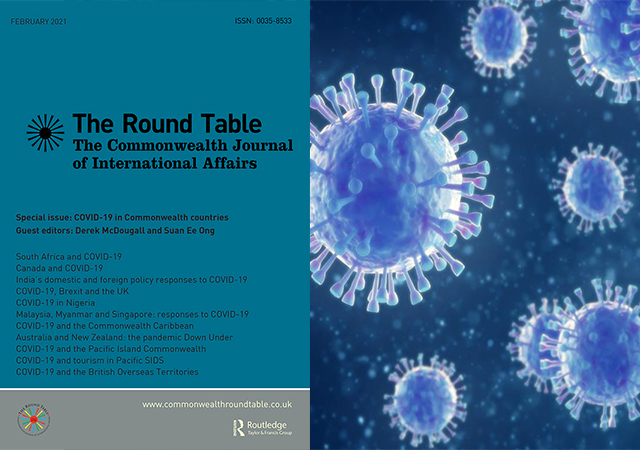
[This is an excerpt from the introduction to a special edition of The Round Table: The Commonwealth Journal of International Affairs.]
2020 has been the year of the COVID-19 pandemic, an annus horribilis. Since the first reported outbreak of the novel coronavirus in Wuhan, China in December 2019, the virus has spread around the world, affecting virtually all countries but with varying impacts. By year’s end, the number of cases recorded was about 75 million, with deaths totalling about 1.7 million. In terms of total case numbers, the top five affected countries in order were the United States, India, Brazil, Russia and France (Worldometer, 17 December 2020). In relative terms (using number of cases per million people), the worst affected countries with populations over 10 million were the Czech Republic, Belgium and the US, in descending order. The US, with a population of about 333 million, had recorded 17.4 million cases and 314,577 deaths as of 17 December. The way the pandemic has evolved raises questions about why and how countries have responded and how effective their policies have been.
From the perspective of this special issue on ‘COVID-19 in the Commonwealth world’, we need to ask what the value of a Commonwealth perspective is on these general issues concerning the pandemic. As with many other global issues, the value of a Commonwealth perspective is that it provides a cross-section of the pandemic experience across the whole world, covering developed and developing countries (and different types within those broad categories), established and emerging powers, some of the most populous countries in different regions, as well as small states and territories. We use the term ‘Commonwealth world’ to indicate that the focus is on countries that are members of the Commonwealth (including dependent territories), rather than on the role of the Commonwealth of Nations or the Commonwealth Secretariat more specifically.
The articles in this special issue cover a number of significant countries and regions within the Commonwealth, without purporting to be comprehensive. There is a strong emphasis on small island states and territories (four articles), but the Commonwealth itself also has that emphasis (32 of 54 members are defined as small states, of which 24 are small island states, or 27 if Belize, Guyana and Brunei are included). The authors come from different parts of the Commonwealth, but Australia is undoubtedly overrepresented, suggesting a bias towards an Antipodean view of the Commonwealth. Australia clearly has a strong focus on the Pacific island countries and Southeast Asia, while also having important links to the United Kingdom and Canada as old Commonwealth countries, and to India as both an emerging power and a prominent Commonwealth member.
The relative impact of COVID-19 varies greatly across the Commonwealth states and dependent territories – from Gibraltar (ranked 32nd by Worldometer, total cases in relation to population, 17 December 2020) to Vanuatu (ranked 215th, bottom of the list of countries and territories). Among the countries covered in this special issue (other than regions and the British overseas territories) the ranking is the United Kingdom (46th), South Africa (77th), Canada (87th), Singapore (96th), India (107th), Malaysia (127th), Myanmar (not a Commonwealth member) (135th), Australia (152nd) and New Zealand (180th). Taking Papua New Guinea and Jamaica as the largest of the Commonwealth Pacific island countries (PICs) and the Commonwealth Caribbean respectively, the ranking is 201st (PNG) and 122nd (Jamaica).
General issues
On the assumption that the Commonwealth countries and territories provide a cross section of the world, it is helpful to read the various articles from the perspective of how they assess responses to the key issues arising from the pandemic. The emphasis across articles will vary, with some articles attempting to be comprehensive, while other articles focus more on particular aspects. The key issues covered are public health responses, economic responses and consequences, the relevance of domestic politics, and the pandemic’s impact on geopolitics.
Public health responses
From a public health perspective, COVID-19 has stretched national health systems across the globe to their limits. All countries and territories featured in this issue grappled with the same slate of fundamental public health challenges: testing, tracing, and isolation of potentially exposed or infected individuals, suppressing transmission in the general population, protecting healthcare workers, preventing patients’ progression to severe disease or death, keeping up with the latest developments in drug, treatment, and vaccine technologies, and maintaining delivery of essential health and social care services. Despite these shared challenges, public health responses to the pandemic reflected differences at the confluence of political will, sociocultural acceptability, disease burden, and ability to amass, deploy, and distribute financial and human resources.
For a pandemic occurring in the modern era of globalisation, information exchange, and movement of persons and goods, a main challenge for national governments has been what strategy to choose to manage COVID-19.
Derek McDougall is with the School of Social and Political Sciences, University of Melbourne , Australia.



